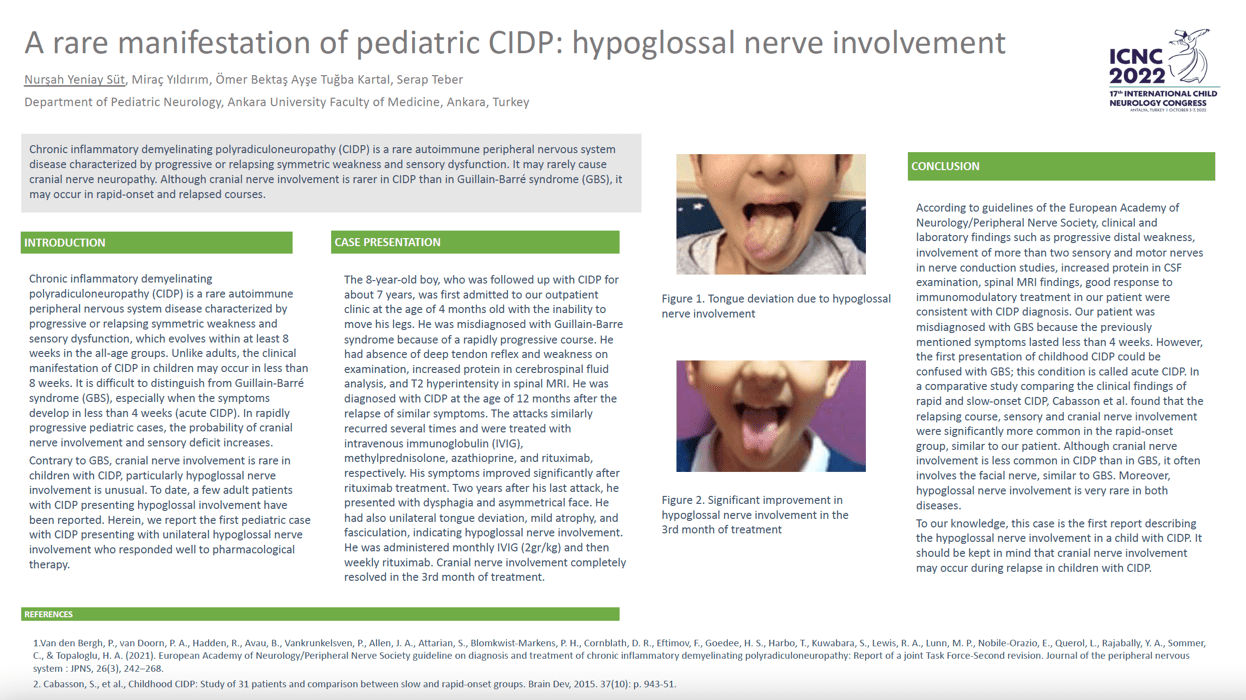A rare manifestation of pediatric CIDP: hypoglossal nerve involvement
Nurşah Yeniay Süt, Ömer Bektaş, Miraç Yıldırım, Ayşe Tuğba Kartal, Serap Teber
Objective: Chronic inflammatory demyelinating polyradiculoneuropathy (CIDP) is a peripheral nervous system disease, characterized by symmetric weakness and sensory dysfunction. However, it can rarely relapse with cranial nerve involvement. We aimed to present an 8-year-old boy with hypoglossal nerve involvement, which has not been described before in children. Case Presentation: The 8-year-old boy, who was followed up with CIDP for about 7 years, was first admitted to our outpatient clinic at the age of 4 months old with inability to move his legs. He was misdiagnosed with Guillain-Barre syndrome because of rapidly progressive course. He had absence of deep tendon reflex and weakness on examination, increased protein in cerebrospinal fluid analysis, and T2 hyperintensity in spinal MRI. He was diagnosed with CIDP at the age of 12 months after the relapse of similar symptoms. The attacks similarly recurred several times and were treated with intravenous immunoglobulin (IVIG), methylprednisolone, azathioprine, and rituximab, respectively. His symptoms improved significantly after rituximab treatment. Two years after his last attack, he presented with dysphagia and asymmetrical face. He had also unilateral tongue deviation, mild atrophy and fasciculation, indicating hypoglossal nerve involvement. He was administered monthly IVIG (2gr/kg) and then weekly rituximab. Cranial nerve involvement completely resolved in the 3rd month of treatment. Conclusion: To our knowledge, this case is the first report describing the hypoglossal nerve involvement in a child with CIDP. It should be kept in mind that cranial nerve involvement may occur during relapse in children with CIDP.
Keywords: CIDP, cranial nerve involvement, cranial neuropathy, hypoglossal nerve involvement
Nurşah Yeniay Süt
Ankara University Faculty of Medicine
Turkey
Ömer Bektaş
Ankara University Faculty of Medicine
Turkey
Miraç Yıldırım
Ankara University Faculty of Medicine
Turkey
Ayşe Tuğba Kartal
Ankara University Faculty of Medicine
Turkey
Serap Teber
Ankara University Faculty of Medicine
Turkey
Objective: Chronic inflammatory demyelinating polyradiculoneuropathy (CIDP) is a peripheral nervous system disease, characterized by symmetric weakness and sensory dysfunction. However, it can rarely relapse with cranial nerve involvement. We aimed to present an 8-year-old boy with hypoglossal nerve involvement, which has not been described before in children. Case Presentation: The 8-year-old boy, who was followed up with CIDP for about 7 years, was first admitted to our outpatient clinic at the age of 4 months old with inability to move his legs. He was misdiagnosed with Guillain-Barre syndrome because of rapidly progressive course. He had absence of deep tendon reflex and weakness on examination, increased protein in cerebrospinal fluid analysis, and T2 hyperintensity in spinal MRI. He was diagnosed with CIDP at the age of 12 months after the relapse of similar symptoms. The attacks similarly recurred several times and were treated with intravenous immunoglobulin (IVIG), methylprednisolone, azathioprine, and rituximab, respectively. His symptoms improved significantly after rituximab treatment. Two years after his last attack, he presented with dysphagia and asymmetrical face. He had also unilateral tongue deviation, mild atrophy and fasciculation, indicating hypoglossal nerve involvement. He was administered monthly IVIG (2gr/kg) and then weekly rituximab. Cranial nerve involvement completely resolved in the 3rd month of treatment. Conclusion: To our knowledge, this case is the first report describing the hypoglossal nerve involvement in a child with CIDP. It should be kept in mind that cranial nerve involvement may occur during relapse in children with CIDP.
Keywords: CIDP, cranial nerve involvement, cranial neuropathy, hypoglossal nerve involvement
Nurşah Yeniay Süt
Ankara University Faculty of Medicine
Turkey
Ömer Bektaş
Ankara University Faculty of Medicine
Turkey
Miraç Yıldırım
Ankara University Faculty of Medicine
Turkey
Ayşe Tuğba Kartal
Ankara University Faculty of Medicine
Turkey
Serap Teber
Ankara University Faculty of Medicine
Turkey

Nurşah Yeniay Süt
Ankara University Faculty of Medicine Turkey
Ankara University Faculty of Medicine Turkey